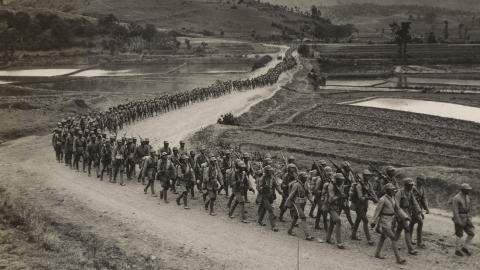Admiral Karl Dönitz: Head of the Nazi's U-Boats and Hitler's successor
Early career
Karl Dönitz entered the German Imperial Navy in 1910 at the age of nineteen. Commissioned as an officer in 1913, he requested a transfer to the submarine force in 1916, passing out of submarine school in 1917. By 1918, he was the captain of U-68. His time in charge did not last long. Forced to surface due to technical issues in the Mediterranean, Dönitz chose to scuttle his boat instead of letting it be captured by the Royal Navy.
He spent the remainder of World War I as a prisoner of war. It was during his time as a prisoner that he devised the tactic that would prove so devastating to Allied shipping in the Second World War - the ‘wolfpack’.
The interwar years
Dönitz chose to remain in the Navy after Germany surrendered in 1918. Over the next seventeen years, he rose through the ranks. In 1935, two years after the Nazis rose to power, Grand Admiral Erich Raeder, the head of the German Navy, put Dönitz in charge of Germany’s submarine fleet. By 1939, Dönitz had 59 U-boats at his disposal, which he soon put to devastating use.
‘I rate Admiral Dönitz as the best of them all, land or sea. He was unique in his handling of the German submarines and they were our most dangerous enemy. His performance with them - and he did most of it himself - was the most outstanding Axis performance of the war.’
- Admiral Thomas C. Hart, US Navy.
World War II
Britain declared war on Germany on 3rd September 1939. Within hours, the British ocean liner SS Athenia was sunk by the U-boat U-30. It was the opening salvo of the Battle of the Atlantic - the longest and most complex battle of the Second World War.
To break Britain after the Luftwaffe failed to gain air supremacy over the RAF in 1940, Dönitz told Raeder that Britain’s reliance on overseas trade was its Achilles’ Heel. If enough merchant shipping could be targeted and destroyed, he argued, the country would be forced to drop out of the war. Raeder agreed and charged Dönitz and his submarine fleet with delivering the knockout blow.
The Battle of the Atlantic
From the beginning of the war, Britain organised its transatlantic merchant ships into convoys which were escorted by warships of the Royal Navy. Dönitz ordered his submarines to attack them using the ‘wolfpack’ tactic. Several U-boats spread out across an area of the ocean, waiting for a convoy to come into view. When one did, the U-boats would converge on the convoy and attack it en masse. The tactic was spectacularly successful. Convoy after convoy was attacked, with a huge loss of life and ships.
The fall of Norway and France meant Dönitz could base his submarines on the Atlantic coast, from where he directed U-boat operations personally by radio and encrypted messages. The location of the German submarine bases vastly increased the length of time U-boats could be deployed, wreaking further havoc on British shipping. Despite stronger Royal Navy and Royal Canadian Navy protection of merchant shipping, the wolfpack attacks continued to be successful. However, the entry of America and its US Navy submarine hunter-killers into the war changed the game. There were now warships from three navies hunting for Dönitz’s U-boats, and losses mounted.
Advances in submarine detection technology, the breaking of encrypted German communication codes and the introduction of transatlantic air support further added to the Germans’ woes. By 1943, despite sinking over six million tonnes of Allied shipping that year, the U-boats were suffering huge losses and could not sink more ships than the Allies could build.
After D-Day in June 1944, Germany lost its submarine bases in France and what remained of its submarine fleet was reduced to hassling shipping around the British coast. A combination of technological advancement and the sheer weight of numbers the Allies could throw into the fight meant Germany could not hope to win the Battle of the Atlantic. By the end of the battle, 30,000 U-boat sailors had died and 648 submarines had been destroyed. Dönitz continued to throw the submarines he had left into the fight right up until 1945, primarily to relieve pressure on other branches of the German armed forces.
Head of State
Dönitz was named Hitler’s successor in his last will and testament. He became the second and last leader of Nazi Germany when the Führer committed suicide on 30th April 1945. He ordered Alfred Jodl, the head of the German armed forces, to surrender to the Allies. The German instruments of surrender were signed by Jodl in Reims, France on 8th May 1945. Dönitz carried on as the head of the German government until it was disbanded by the Allies on 23rd May.
After the war
Dönitz stood trial for crimes against peace, war crimes and crimes against humanity at Nuremberg. He was found guilty of the first two indictments, but not of the last, which would have cost him his life. He served ten years in Spandau Prison in West Berlin. Released in 1956, Dönitz retired to a small village near Hamburg where he lived - still unrepentant about his role in the war and still loyal to Hitler - until he died of a heart attack on Christmas Eve 1980. He was buried in Waldfriedhof Cemetery without military honours.
















